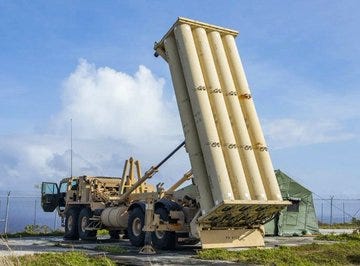Yesterday I reported the news that the US is deploying a THAAD battery (that last word is important, remember it) to Israel, to be manned by 100 US personnel. It appears that this deployment is a replacement for the THAAD battery that had been in place in Israel since 2019—apparently manned by Israelis. Iran claims to have taken out that battery in their most recent demonstration strike, so the US deployment is a replacement. The bigger question, which we’ll return to, is: Is this deployment some sort of trip wire or, as I speculated yesterday, are the US personnel intended to serve as a sort of human shield to deter Iran from taking out the new THAAD battery? But before we get to that important question, let’s do some background on THAAD itself.
The first thing to know about THAAD is that it is virtually untested in the real world. Wikipedia claims:
On 17 January 2022, THAAD made its first operational interception, of an incoming hostile medium-range ballistic missile in the UAE.
However, that article makes no mention of THAAD’s performance against the most recent Iranian strike. Given that the Iranian strike was highly impressive and effective, it follows that THAAD’s performance was quite unimpressive—especially if it was taken out in whole or part by the Iranians, who did use hypersonic missiles in their strike. The best information is that THAAD is defenseless against hypersonic missiles.
Here is a tweet that sketches out THAAD in concept—note the makeup of a single battery:
THAAD Defense:
•Each battery consists of 6-9 launchers
•Each launcher can hold 8 interceptors.
•The system can operate with either 1 or 2 Tactical Station Groups.
•It is compatible with commercial power.
•The system is expandable, meaning it can be adjusted to meet specific defense needs.
•Launch Control Station (LCS): Manages the launch process.
•Station Support Group (SSG): Provides logistical and operational support.
•Tactical Operations Station (TOS): Central for operational control.
•Prime Power Unit (PPU): Supplies necessary power.
•Cooling Equipment Unit (CEU): Maintains temperature control.
•Antenna Equipment Unit (AEU): Handles communication sig nals.
•Electronics Equipment Unit (EEU): Manages the electronics for operational control.
•Fiber Optic Links: Ensures data transfer between components.
•Radar Group: Includes radar systems for tracking and intercepting threats.
Total Interceptors:
•A fully loaded THAAD battery can have up to 72 interceptors, with up to to 9 launchers depending on configuration.
Sounds impressive. But … The Patriot sounded impressive, in concept, too. Patriot has turned out to be a dismal, extremely expensive failure. That failure was entirely foreseeable, as it turns out, but was covered up by fudging the testing and performance during the Gulf War. THAAD, which is essentially untested in the real world, may be a product of that same corrupt procurement system.
You can read about the development and testing of THAAD, and it doesn’t come across as terribly impressive. In fact:
Will Schryver @imetatronink
 People forget that the testing performance of the THAAD system was so abysmal they had to repeatedly "dumb down" the test scenarios until it was possible for the missiles to achieve a kill.
They are sending THAAD to Israel because they're desperate and have nothing else.
7:05 PM · Oct 13, 2024
Jacub @jacubkobak
Also, correct me if I'm wrong, but doesn't THAAD essentially serve the same function as Israel's Arrow 3?
Will Schryver @imetatronink
Yes. Both serve as the basis of the longstanding myth that western air defenses can actually defend against salvos of high-speed ballistic missiles -- a myth that the Russians and Iranians have now decisively busted.
Here’s another problem, which we’ve seen demonstrated repeatedly since Russia’s SMO began, as well as during the past year in the Middle East:
M @1337gun
The meat of all this is that there are just 72 interceptors, and if you do the usual math of 2 interceptors per missile and around 80% success rate then it means all that’ll take to overcome this is 28 missiles, and they don’t even have to be real ones, decoys will do. Pathetic
And if the Iranians are correct in asserting that they took out the Israeli THAAD battery, the news is much, much worse. Which probably explains why Israel’s military clearly has cold feet about striking at Iran.
thequestioner @examcan86
The issue still remains, there aren't enough THAAD batteries in whole world to stop a "small" attack by Iran.
Let alone account for kill probability (KV per RV).
Which leads Will Schryver to conclude:
Will Schryver @imetatronink
 Argue the Contrary If You Can
US/NATO air defenses exist in vanishingly small numbers and range from marginally effective to effectively useless.
The US is effectively defenseless against any missile power capable of launching large salvos in series.
5:13 PM · Oct 13, 2024
Will also takes issue with an Israeli fanboy who, in a super long tweet, sketches out his fantasy of how Israel can certainly take out Iran—as if they wouldn’t have done it already if it were so readily feasible. I won’t quote the long tweet, but it begins:
dan linnaeus @DanLinnaeus
By and large, the Israel Air Force (IAF) possesses the range and capabilities necessary to neutralize the IRGC-AF’s heavily fortified offensive missile infrastructure. This needn’t rely on GB 57 MOPs or similarly massive deep penetration munitions, but can primarily be achieved
By and large? Hmmm. Will responds with a translation of the tweet:
Will Schryver @imetatronink
 TL;DR:
"If our air fleet is at 100% combat-readiness; all our launches and rendezvous are perfectly coordinated; every platform performs at its maximum range with a maximum load; WE MEET NO MEANINGFUL OPPOSITION, and every target is hit perfectly ... we can disarm Iran."
5:53 PM · Oct 13, 2024
Right. However, for those with the endurance to make it through the long fantasy tweet, there’s a brief sentence that gives it all away:
Israel always finds a way to defy gravity, alter realities on the ground (and in the air) and take the region by storm.
Defies gravity? Alters reality on the ground? Wow! We must be talking about The Chosen, the Master Race! Ask yourself: Exactly when was the last time Israel “took the region by storm?” 1982? 2006? 2014? And why has this recent storm on—if not the region, then at least on many tens of thousands of women and children—failed to achieve the loudly proclaimed objectives? Counting on Israel to find a way to defy gravity and alter realities on the ground doesn’t constitute and actual plan. That’s exactly the type of thinking that has led to Israel into repeated debacles—from which the US has been called upon to save their asses. We may just be in the realm of Magical Thinking or even Madness here. But this time the stakes may include global war.
Now, back to the original question. If THAAD is almost certainly not going to prove effective against a concerted Iranian strike, what is the purpose of this deployment? Yesterday I speculated that the US personnel might be serving as a human shield to deter Iran from responding to an Israeli attack. This morning Ray McGovern expressed another scenario that I hestitated to voice. That scenario would run something like this: The US has repeatedly stated that it would provide Israel with defensive systems. That would be THAAD. However, could this replacement THAAD, operated by US personnel, have included a quid pro quo? Could Zhou have told Netanyahu something like this: We will replace your shattered AD system and provide human shields, since the systems themselves don’t work against Iran’s missiles. However, you will be expected to excercise “restraint” in responding to Iran. McGovern states that this possibility is “out there”. But there’s a problem. Iran doesn’t have to buy in:
Iranian FM Araghchi:
"Indirect communication between Iran and the US is currently suspended due to the ongoing regional circumstances, and there is no foundation for resuming these talks at this time. We do not seek war, though we are fully prepared for it. We believe that diplomacy must succeed and prevent a major crisis in the region."






Interesting stuff here. https://cdrsalamander.substack.com/p/running-out-of-sm-3-at-sea
"Yes, we only have 7 [THAADs]. They cost $1.25 billion per battery and $12.6 million per missile. From a capability point of view, they are A LOT more expensive than a Navy solution, plus we now have US Army soldiers engaged in a combat role feet-dry ashore in Israel.
"A THAAD battery consists six launchers, each with eight missiles. That gives you 48 missiles. A little more than half a DDG’s worth of VLS cells. I’ll let you multiply 48x7.
Compared to having a couple of DDG off the coast, having US Army forces as active participants on the ground is an escalation in our participation in helping Israel defend herself. It does not matter if you think that is a good thing or a bad thing, but it is reality. It narrows options and increases risks. Ground forces have a very different vibe than capabilities at sea.
"I would presume own supply of Arrow ABM must be running thin. Deploying THAAD could not have been an easy decision for Israel or the USA. This isn’t an exercise, this is varsity football.
"With only seven batteries available and the world generally in disarray, the only reason I can think of that would justify this move is simply that the US Navy just can’t bring enough DDG with SM-3 off Israel to do the job. We’ve shot what we’ve got…at least for a bit. What few we have are located elsewhere with missions of their own."
Alastair Crooke refers to Iran taking out the X-band radar. That's a part of the THAAD battery, but not the battery itself.